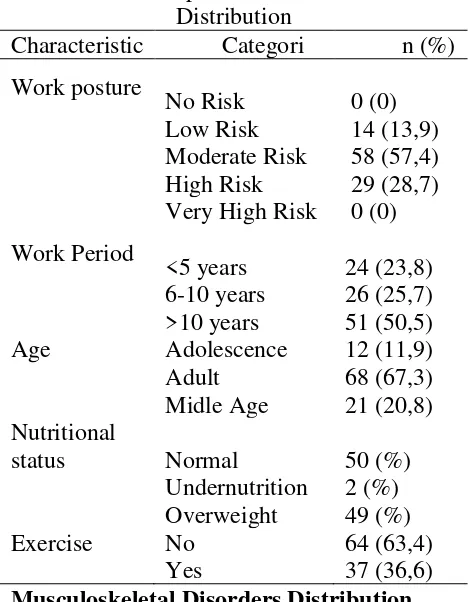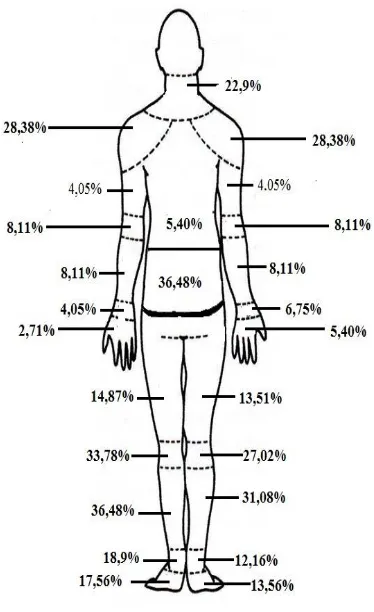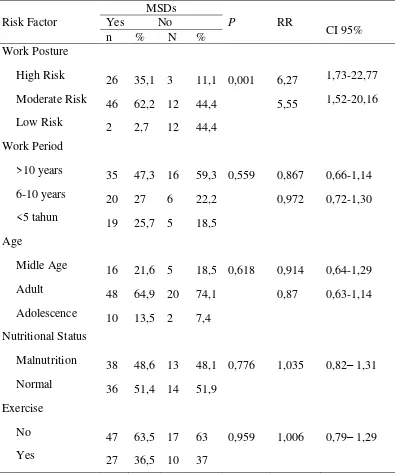Analysis of Work Posture Using Rapid Entire Body Assessment
(REBA) as the Risk Factor of Work Related Musculoskeletal
Disorders in Inter-provincial Bus Drivers
Fitria Saftarina1*, Diana Mayasari1, Dian Octaviani2
1Department of Community Medicine, Faculty of Medicine, Lampung University, Bandar
Lampung, 35145, Indonesia
2Faculty of Medicine, Lampung University, Bandar Lampung, 35145, Indonesia
* Corresponding Author: Fitria Saftarina,Mailing list E-mail: fitria205@yahoo.co.id , Phone: +62-81272962942,
Background : Inter-provincial bus driver is a job which force a man to work in static posture for a long time. Incorrect posture that occure for a long time may become a risk factor of
Musculoskeletal Disorders (MSDs). This study was aimed to identify work-related MSDs and its association with work posture and other related factors in inter-provincial bus drivers in
Bandarlampung.
Materials and methods: This was a cross sectional study which involved 101 inter-provincial bus drivers obtained by consecutive sampling technique. Musculoskeletal disorders were assessed using Nordic Body Map, while work posture was assessed using Rapid Entire Body Assessment (REBA). Infomation about participant demographics was also collected by quetionnaire.
Results: prevalence of MSDs was 73.3% and were mostly located in the lower back (36.48%) , calves (31.08%) and shoulders (28.38%). Most subjects (66.2%) had moderate risk of work posture. There was significant association between MSDs with high risk work posture (p=0.001, RR=6.27, 95% CI=1.73-22.77); but there was no significant association with work period, age, nutritional status, and exercise.
Conclusions : High risk work posture is a risk factor of MSDs which significantly increase the risk to the occurance of MSDs in inter-provincial bus driver.
Keywords : Bus driver, musculoskeletal disorders, work posture, REBA
Introduction
Musculoskeletal Disorders (MSDs) is one of work-related disease and contributed for 41% of all work-related disease in Great Britain and caused 37% of workers absentism.[1] In 2003, World Health Organization (WHO) had reported MSDs as most common work-related disease and was estimated to account for 60% of all occupational diseases. According to the Ministry of Health of the Republic of Indonesia in 2005, 40.5% of workers in Indonesia had work-related diseases, where 16% was musculoskeletal disorders, 6% was cardiovascular disease, 1.3% skin disease and 1% ENT disorders. MSDs is occure by the
contribution of various risk factors, including individual, occupational and psychosocial risk factors.[2,3] Transportation workers, for example is bus driver who are at risk of health problems such as MSDs, psychological problems such as fatigue and tension, intestinal disorders, and sleep disorders. These problems could result in the driving performance of the bus driver.[4]
conducted on bus drivers in Tricity found the prevalence of MSDs among drivers was 51% with the location of musculoskeletal disorders most frequently to occured at the lower back (30.3%), followed by neck (17.3%) and knee (14.7%).[4]
According to preliminary study conducted by observation and interview on inter-provincial bus drivers who work 12-24 hours at Rajabasa Bus Station in Bandar Lampung, found that 16 out of 20 bus drivers suffered from MSDs and The location of MSDs most frequently occured were on the waist and ankles. Bus driver must work in a static sitting position and be exposed by long-lasting vibrations. Static posture and unergonomic posture is some of risks faced by bus drivers repeatedly every day and are factors that can lead to MSDs and can have an impact on how he drive the bus that might lead to road accident. the objectives of this study was to identify and quantify ergonomics working postures in
inter-provincial bus drivers that may
contribute to the serious development of musculoskeletal disorders and investigate other possible contributory causes with the intention of prevention.
Methods
This was an observational, quantitative study with cross sectional design. The study was conducted in Bandar Lampung. The study population was inter-provincial bus drivers in Bandar Lampung. Sample was selected using a consecutive sampling technique. Bus drivers who had a history of bone fracture and were
diagnosed with the disease on the
musculoskeletal system before working as a driver were excluded. The number of subjects in this study was 101 inter-provincial bus drivers.
Musculoskeletal Disorders were identified using Nordic Body Map to gathered information about pain and located the area. Work postures were documented by taking pictures of respondents on their driving potures using cameras. Body angels were then
measured from the pictures and given scores using Rapid Entire Body Assessment (REBA) to identify the risk level of work posture. Other data such as age, work periode, BMI, and exercise also gatherd in this study. Data were analyzed using chi-square test. The analysis results were determined with p <0.05 and 95% confidential intervals (CI).
Results
Respondents Characteristic
There was 115 respondents joined this study, but only 101 respondents who meet the criteria to be the subject. Those subjects were inter-provincial bus drivers who had route: Ranau-Jakarta, Lahat-Bekasi, Yogya-Jambi,
Yogya-Pekanbaru, Bandung-Pagaralam,
Jambi-Pati, Jambi-Bali, Jakarta-Belitang,
Medan-Bali and Lampung-Cilacap. Those routes takes about two until five days driving on the road. Only few drivers who had a crew to exchange driving, the driver's turnover cycle is about every 6 to 10 hours. Some
subjects didn’t have crew to exchange driving
and just took a rest in the ship and rest areas about three to four hours. Respondents characteristic is presented in Table 1.
Table 1. Respondents characteristic Distribution
Characteristic Categori n (%)
Prevalence of MSDs among inter-provincial bus drivers in Bandar Lampung found from this study was 73.3%. MSDs were mostly located on the lower back and followed by calves, knees, neck and shoulders. More data is presented in Figure 1.
Figure 1. Location of MSDs
The association of Musculoskeletal Disorderss with several risk factors.
Table 2. The association of MSDs with several risk factors
Risk Factor
MSDs
P RR
Yes No
CI 95%
n % N %
Work Posture
High Risk 26 35,1 3 11,1 0,001 6,27 1,73-22,77
Moderate Risk 46 62,2 12 44,4 5,55 1,52-20,16
Low Risk 2 2,7 12 44,4
Work Period
>10 years 35 47,3 16 59,3 0,559 0,867 0,66-1,14
6-10 years 20 27 6 22,2 0,972 0,72-1,30
<5 tahun 19 25,7 5 18,5
Age
Midle Age 16 21,6 5 18,5 0,618 0,914 0,64-1,29
Adult 48 64,9 20 74,1 0,87 0,63-1,14
Adolescence 10 13,5 2 7,4
Nutritional Status
Malnutrition 38 48,6 13 48,1 0,776 1,035 0,82– 1,31
Normal 36 51,4 14 51,9
Exercise
No 47 63,5 17 63 0,959 1,006 0,79– 1,29
Yes 27 36,5 10 37
Discussion
Prevalence of MSDs among inter-provincial bus drivers in this study was found to be 73.3%. most common location of MSDs in subjects was found on the lower back area (36,48%), and followed by the calves (36,48%), shoulders (28,38%), left knee (27,02%),and neck (22,9 %). During driving, shoulders, neck, back, and lower extremities are most widely used parts of the body in a long duration and cause excessive use of the muscles at these areas.[6]
serious injury to the spine.[7] When a certain work posture is frequently performed in a long duration of time, the burden might exceeds muscle and tendon ability to adapt that will lead to inflammation which will be followed by tissue degeneration, microcracks and scar tissue formation. Once a muscles or tendons is injured, the surrounding muscles must compensate by working harder to provide support to the body. The increasing of these muscles work will lead to fatigue and stifness on the muscles.[4,7] Besides, a long static work posture in drivers will cause the lack of oxygen supply to the tissues and manifest as MSDs.[8]
The Risk of work posture was assessed using REBA, this measurement will catagorize work posture into no-risk (score 0-1), low risk (score 2-3), moderate risk (score 4-7), high risk (score 8-10), and very high risk (score 11-15).[9] In this study it was found that the REBA score in subjects were in range of 3 to 10 with the average score was 6, and most of subjects had moderate risk in work posture (57.4%). While 28.7% subjects had high risk and 13,9% had low risk in work posture. The result of cross-tabulation between work posture and MSDs also showed that most of subjects who suffered from MSDs are those who had moderate and high risk in work posture. Bivariate analysis using chi-square test showed that there was a significant association between work posture and MSDs occurance in inter-provincial bus drivers. This result is in line with a study conducted by Ojo et al. (2014) which found that there was a significant association between work posture and MSD complaints.[10] The European Agency for Safety and Health at Work (EU-OSHA) states that there is an association between work posture to MSDs, that the work posture is at risk to cause pain when the body is twisting, bending or performing a posture which body angles are exceeding the normal body angles and are performed > 25% of working time.[8] Postural problems also
relate to awkward posture, repetitive
movement, excessive body usage, and improper working environment.[11]
Several studies had confirm the association between awkward posture with the risk of developing musculoskeletal pain. There is an
increased in risk of musculoskeletal
symptoms in the neck and shoulders when the neck is twisted or bent. The risk of neck pain increases when the neck is twisted more than 45 degrees for more than 25% of working time. An Increased risk also occurs when the neck is bent more than 45 degrees from natural neck position for more than 5% of the working time. However, if the neck is bent at a 20-degree or more for more than 40% of the working time, the risk of musculoskeletal pain increases rapidly along with the time.[12] The measurement of neck angle in subjects of this shown that some subjects had an upright neck position (10-20 degrees) but some of them had a bent neck position lower than 20 degrees that will lead to the occurance of musculoskeletal disorders on the neck and shoulders.
REBA measurement on the trunk had found that most ssubjects had extension and upright position (10-20 degrees), only a small percentage of respondents trunk are bent at an angle more than 20 degrees. The position of the respondent's upper arm was at the angle of 20-45 degrees and 45-90 degrees, while the position of the forearm at the angle of 60-100 degrees and > 100 degrees which might lead to cause pain at the elbow.
Many pain complaints are located in the lower back area. Working on a bent or twisted position for more than two hours a day is a strong risk factor for back pain. Bending and
twisting more than 30 degrees and
Figure 2. Measurement of body angle
The results of this study also showed that respondents who suffered from MSDs were mostly (47.3%) had been working as a bus drivers for more than 10 years, but the results of bivariate analysis showed that there was no significant association between work period with MSDs among inter-provincial bus drivers. This results is contrary with the result from a research conducted by Firmanita (2015) to taxi drivers in Semarang which found that work period of> 10 years had a significant association MSDs with a working period against MSDS.[14]
Research by Hakkanen (2001) showed that the absenteeism due to sick leave was increased on workers with longer work period, it also explained that adaptation to work does not reduce the problem. Even new workers who just start to work and get used to
the task might also suffered from
musculoskeletal disorders due to the repetitive activities.[15] group had greater risk of MSDs where 76.2% subjects whose age >45 years suffered from drivers which found a significant association between age and MSD.[16] The theory said respondents were mostly in the adult age (26-45 years) in which the functional muscles were still working well, and most respondents were not in a high risk range in generating MSDs.
Data analysis on respondents nutritional status had found that respondents who suffered from MSDs were mostly malnutrition(51.4%), but bivariate analysis found no significant association between nutritional status with MSDs occurance. This is in contrast to the results of a study conducted by Viester et al. (2013) which found that BMI had a significant association with musculoskeletal
disorders, particularly in lower
The result of this study also showed that respondents who suffered from MSDs were more in the group of subjects who did not exercise (55,4%). However the results of bivariate analysis showed that there was no significant association between exercise and MSDs among inter-provincial bus drivers. The results of this study contrary with the result of study conducted by Ariani (2009) which stated that workers with low physical fitness will tend to suffered from MSDs.[21] However, the results of this study are consistent with a study conducted by Nurliah
(2012) which stated that there was no significant association between exercise with the occurance of MSDs. But cross-tabulation showed that subjects in both groups who exercised and did not exercise were mostly suffered from MSDs. This is probably due to the duration of static posture in a long time during work. As the theory stated by Flaspoler (2007) that static work posture will
cause lack of oxygen supply to
muskuloskeletal tissues and cause MSDs.[8]
Conclusions
The prevalence of MSDs`among inter-provincial bus is 73.3% and mostly are drivers. Ergonomic work posture urgently required to be applied among bus drivers to reduce the incidence of MSDs and to improve their quality of live.
References
1. Health and Safety Executive.
Work-Related Musculoskeletal Disorder ( WRMSDs ) Statistics , Great Britain 2016. 2016
2. Batham C and Yasobant S. A Risk
Assessment Study on Work-Related
Musculoskeletal Disorders among
Dentists in Bhopal, India. Indian J Dent
Res. 2016;27(3):236–41.
3. Cho K, Cho HY, Han G. Risk Factors
Associated with Musculoskeletal
Symptoms in Korean Dental
Practitioners. Journal of Physical
Therapy Science. 2016;28(1):56–62.
4. Lalit, Soni R, and Garg S. The Prevalence
of Musculoskeletal Disorders Among Bus Drivers in Tricity. Int J Physiother.
2015;2(5):850–54.
5. Wintoko, Risal. Hubungan Duduk Statis
Dengan Faktor Resiko Terjadinya Nyeri Punggung Bawah Pada Supir Bus Di Terminal Raja Basa Bandar Lampung.
JUKE. 2013;3(1):27–8.
6. Tamrin, S. B. M. et al. The Association
between risk factors and low back pain among commercial vehicle drivers in peninsular Malaysia: a preliminary result. Ind. Health. 2007;45: 268–278 .
7. Nunes IL, Bush PM. Work-Related
Musculoskeletal Disorders Assessment and Prevention, Ergonomics - A Systems
Expert forecast on Emerging Biological Risks related to Occupational Safety and Health. Sperimentale.2007.
9. Hignett S, McAtamney L. Rapid Entire
Body Assessment (REBA). Applied Ergonomics. 2000;31(2): 201–5.
10. Ojo OA, Oluwaseun O, Rufus A, Adaobi
O. Assessment of work related
musculoskeletal pain among professional drivers in the service of a tertiary institution. Am J Pharm Health Res.2014;2(5-1): 56-60.
11. Veelaga P, Telaprolu N. Work Poture and
Prevalence of Musculoskeletal Symptoms among Women in Packing Activities of Pharmaceutical Industry. Int J Cur Res Rev. 2013;5(17): 57-65.
12. Liu D. Risk Factors for Musculoskeletal
13. Nieuwenhuyse AV, Somville PR,
Crombez G, Burdorf A, Verbeke G,
Johannik K, et al. The role of physical
workload and pain related fear in the development of low back pain in young workers: evidence from the Blowback study; results after one year of follow up. Occup Environ Med. 2006;63(1): 45-52.
14. Firmanita SD, Rosdiana I, Indrayani UD.
2015. The Correlation between Duration
of Employment, Body Posture and Smoking Habit on Low Back Pain Incidence: An Analytic Observational Study among Taxi Driver in Semaang Municipality. Sains Medika. 2015;6(1): 17-20.
15. Häkkänen M, Viikari-Juntura E, and
Martikainen R. Job Experience, Work Load, and Risk of Musculoskeletal
Disorders. Occup Environ Med.
2001;58:129–35.
16. Viester L, Verhagen EA, Oude Hengel
KM, Koppes LL, van der Beek AJ,
Bongers PM. The relation between body
mass index and musculoskeletal symptoms in the working population.
BMC Musculoskelet Disord.
2013;14:238.
17. Mozafari A, Vahedian M, Mohebi S,
Najafi M. Work-related musculoskeletal
disorders in truck drivers and official workers. Acta Med Iran. 2015l53(7): 432-38.
18. Marras W. and Karwowski W.
Interventions, Controls And Applications In Occupational Ergonomics. USA: University of Louisville. 2006.
19. Tarwaka. Ergonomi Untuk Keselamatan,
Kesehatan Kerja Dan Produktivitas. Surakarta: UNIBA PRESS. 2004.
20. O’Malley G. Musculoskeletal Disorders in Obesity. Dalam F. Wilson, J. Gormley,
dan J. Hussey, eds. Excercise Therapy ini
the Management of Musculoskeletal Disorders. UK: Blackwell Publishing.
2011;231–40.
21. Studebaker C, Murphy B. Current



